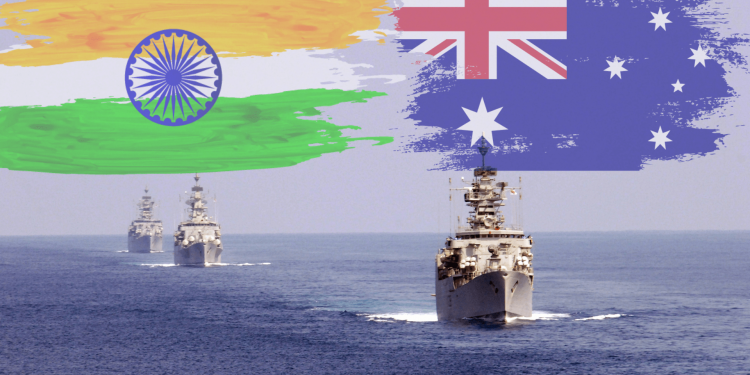In recent months, there has been a substantial improvement in India-Australia defence ties, with more cooperation between the two maritime countries during bilateral and multilateral military exercises.
As a gateway to the Indian Ocean, the marine seas between Indonesia and northern Australia are of significance to both nations. Indirectly addressing the prospect of Chinese expansionism that has created strategic concerns in the area, these drills have reinforced the shared aims of an open, inclusive, and rules-based Indo-Pacific region.
Following the meeting between Australian Defence Minister Richard Marles and Indian Defence Minister Rajnath Singh in New Delhi in June, several similar drills have been conducted. The India-Australia Comprehensive Strategic Partnership, founded on mutual trust and understanding, shared values, and common interests of democracy and rule of law, is primarily driven by defence and security.
The heads of the Australian army and navy visited India in April during a series of high-level visits, prompting Australia’s high commissioner to India, Barry O’Farrell, to observe that collaborative defence engagements had increased almost four-fold since 2014.
The Indian Navy and Royal Australian Navy conducted their Maritime Partnership Exercise off Perth on August 19 and 20, less than a month after the defence ministers’ meeting, reasserting their close interoperability and strong navy-to-navy ties. The INS Sumedha, an offshore patrol ship built in India, joined the HMAS Anzac to perform tactical manoeuvres, a goodbye steam past, and a cross-deck landing of helicopters.
The drill also followed the combined instructions given by the heads of the two nations’ fleets in August 2021.
2,500 military personnel from 17 air forces participated in Exercise Pitch Black 2022, the Royal Australian Air Force‘s (RAAF) capstone biennial engagement with important strategic partners, from August 19 to September 8, flying four Russian Sukhoi-30MKI fighters and two Boeing C-17 Globemaster military-transport aircraft.
More than 100 members of the Indian Air Force flew the C-17 Globemaster and two other types of aircraft. This massive exercise, which was held at the RAAF facilities in Darwin, Tindal, and Amberley after a four-year break due to Covid-19, included a variety of realistic and simulative complex aviation scenarios involving huge formations.
Four days after Pitch Black concluded, the RAN, with assistance from the RAAF, staged Kakadu 2022, its other major biannual exercise, on land in Darwin and in the waters off northern Australia. Since its commencement in 1993, the 12-day exercise has expanded in size and complexity, and this time it included ships and marine aircraft from 14 navies. India took part with a Boeing P-8I maritime patrol and reconnaissance aircraft and the INS Satpura, a 6,000-ton guided-missile stealth frigate that was developed and built indigenously.
Rear Admiral Christopher Smith, the deputy chief of the RAN, and Rear Admiral J. Singh, the assistant chief of the Indian naval staff, acknowledged the two nations’ growing cooperation amid emerging challenges on the maritime front during the 14th India-Australia navy-to-navy staff talks that took place over three days. The discussions took place under the framework of the 2021 Joint Guidance for the Navy-to-Navy Relationship between India and Australia, the first such agreement signed by the Indian Navy with any nation.
In addition, the two countries biannual naval exercise AUSINDEX, which was in its fourth iteration at the time, was staged in Australia. The exercise, which first took place in 2015, has become increasingly intricate and now includes complicated surface, subsurface, and air operations involving ships, submarines, helicopters, and long-range maritime patrol aircraft from both nations.
Australia has just recently joined the annual Malabar exercise, which began in 1992 as a bilateral exercise in the Indian Ocean between the US and Indian fleets. Malabar is a crucial operation involving the four Quad nations since Australia and Japan joined as permanent members in 2015 and 2020, respectively.
The Quad foreign ministers underlined their resolve to resist any unilateral steps that aim to alter the Indo-Pacific status quo in September.
From November 8 to 18, these four formidable warships will conduct Malabar drills off Yokosuka, Japan. Carrier Strike Group 5 is now based in the Yokosuka base of the US Navy, which is commanded by USS Ronald Reagan. The more advanced drills will include wargaming manoeuvres and live firing. When the Republic of Singapore Navy also participated in Malabar in 2007, the RAN also took part.
The RAN also sent HMAS Arunta to Milan 2022, the biggest multinational exercise in India, for the first time this year. Milan 2022’s 11th iteration with the theme “Camaraderie, cohesiveness, and collaboration.” The biannual exercise, which brought together 26 ships, one submarine, and 21 aircraft from 16 navies from all around the Indo-Pacific, took place in March at the port of Visakhapatnam and the Bay of Bengal.
At the end of this month, Visakhapatnam will serve as a port of call for Indo-Pacific Endeavour 2022, an important Australian initiative for regional interaction that travels across Southeast Asia and the northeast Indian Ocean from September to November.
A Maritime Task Unit consisting of RAN ships, Australian Army forces on board, and RAAF air mobility aircraft for fly-in, and fly-out engagements, totalling 1,800 personnel, five ships, and eleven helicopters, will support these engagements with a record 14 nations. The landing helicopter dock HMAS Adelaide, a Canberra-class vessel, will serve as the task group’s focal point.
In order to fulfil the goal of the 2016 defence white paper to increase Australia’s participation and alliances with regional security forces, Indo-Pacific Endeavour was launched in 2017 as an annual program.
The India-Australia Joint Working Group on Defence Research and Materiel Cooperation will also soon convene in Australia. In order to strengthen supply chains’ resilience and provide capabilities to each country’s armed forces, the group will look into further prospects for bilateral industrial collaboration. Additionally, India will provide speciality prospects to Australian defence companies.
For combined training and military-to-military exposure, both partner nations have established programmes to facilitate the interchange of young officers from their armed forces.











